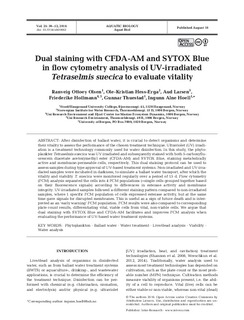| dc.contributor.author | Olsen, Ranveig Ottøy | |
| dc.contributor.author | Hess-Erga, Ole-Kristian | |
| dc.contributor.author | Larsen, Aud | |
| dc.contributor.author | Hoffmann, Friederike | |
| dc.contributor.author | Thuestad, Gunnar | |
| dc.contributor.author | Hoell, Ingunn Alne | |
| dc.date.accessioned | 2018-06-13T10:26:21Z | |
| dc.date.available | 2018-06-13T10:26:21Z | |
| dc.date.created | 2016-10-19T13:33:37Z | |
| dc.date.issued | 2016 | |
| dc.identifier.citation | Aquatic Biology. 2016, 25, 39-52. | nb_NO |
| dc.identifier.issn | 1864-7790 | |
| dc.identifier.uri | http://hdl.handle.net/11250/2501404 | |
| dc.description.abstract | After disinfection of ballast water, it is crucial to detect organisms and determine their vitality to assess the performance of the chosen treatment technique. Ultraviolet (UV) irradiation is a treatment technology commonly used for water disinfection. In this study, the phytoplankter Tetraselmis suecica was UV irradiated and subsequently stained with both 5-carboxyfluorescein diacetate acetoxymethyl ester (CFDA-AM) and SYTOX Blue, staining metabolically active and membrane-permeable cells, respectively. This dual staining protocol can be used to assess samples during type approval of UV-based treatment systems. Non-irradiated and UV-irradiated samples were incubated in darkness, to simulate a ballast water transport, after which the vitality and viability T. suecica were monitored regularly over a period of 15 d. Flow cytometry (FCM) analysis separated the cells into 4 FCM populations (=single cells grouped together based on their fluorescence signals) according to differences in esterase activity and membrane integrity. UV-irradiated samples followed a different staining pattern compared to non-irradiated samples, where 1 specific FCM population of cells expressed esterase activity, but at the same time gave signals for disrupted membranes. This is useful as a sign of future death and is interpreted as an ‘early warning’ FCM population. FCM results were also compared to corresponding plate count results, differentiating vital, viable cells from vital, non-viable cells. We argue that dual staining with SYTOX Blue and CFDA-AM facilitates and improves FCM analysis when evaluating the performance of UV-based water treatment systems. | nb_NO |
| dc.language.iso | eng | nb_NO |
| dc.publisher | Inter Research | nb_NO |
| dc.rights | Navngivelse 4.0 Internasjonal | * |
| dc.rights.uri | http://creativecommons.org/licenses/by/4.0/deed.no | * |
| dc.title | Dual staining with CFDA-AM and SYTOX Blue in flow cytometry analysis of UV-irradiated Tetraselmis suecica to evaluate vitality | nb_NO |
| dc.type | Journal article | nb_NO |
| dc.type | Peer reviewed | nb_NO |
| dc.description.version | publishedVersion | nb_NO |
| dc.rights.holder | © The authors 2016 | nb_NO |
| dc.source.pagenumber | 39-52 | nb_NO |
| dc.source.volume | 25 | nb_NO |
| dc.source.journal | Aquatic Biology | nb_NO |
| dc.identifier.doi | 10.3354/ab00662 | |
| dc.identifier.cristin | 1392933 | |
| dc.relation.project | Norges forskningsråd: 208653 | nb_NO |
| cristin.unitcode | 7464,20,15,0 | |
| cristin.unitname | Akvakultur | |
| cristin.ispublished | true | |
| cristin.fulltext | original | |
| cristin.qualitycode | 1 | |

